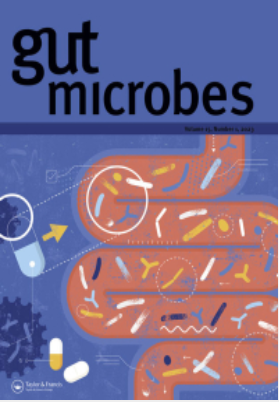Morphine-induced intestinal microbial dysbiosis drives TLR-dependent IgA targeting of gram-positive bacteria and upregulation of CD11b and TLR2 on a sub-population of IgA+ B cells.
IF 12.2
1区 医学
Q1 GASTROENTEROLOGY & HEPATOLOGY
引用次数: 0
Abstract
IgA binding dictates the composition of the intestinal microbiome and reflects dysbiotic states during chronic disease. Both pathogenic and commensal bacteria differentially bind to IgA with varying outcomes. Little is known regarding IgA dynamics immediately following microbial dysbiosis. Recent work shows that morphine treatment rapidly induces microbial dysbiosis within hours of administration. This microbial shift is characterized by the expansion of pathogenic bacteria with a concurrent decrease in commensal bacteria. Because of this rapid microbial shift, a murine model of chronic morphine treatment was used to gain insight on the host IgA response during early microbial disruption. Within 24 h, morphine treatment induces microbial dysbiosis which disrupts IgA-bacterial homeostasis, resulting in an increased concentration of unbound IgA with a corresponding decrease in the frequency of IgA-bound bacteria. Additionally, the increased concentration of unbound IgA is dependent on the microbiome, as microbial depletion abolishes the increase. At 48 h of morphine treatment, the frequency of IgA-bound bacteria increases and IgA-seq reveals increased IgA targeting of gram-positive bacteria. Both a whole-body TLR2 KO and treatment with the TLR inhibitor OxPAPC resulted in abrogation of IgA binding to bacteria, implicating modulation of IgA binding through TLR signaling. Finally, we identify that a sub-population of IgA+ B cells in the intestinal lamina propria has increased CD11b and TLR2 expression at 24 h of morphine treatment which could be a potential source of the observed IgA that targets gram-positive bacteria. Together, we demonstrate for the first time the role of TLR2 in IgA targeting of intestinal bacteria, and this study sheds light on the IgA dynamics during the initial hours of microbial dysbiosis.吗啡诱导的肠道微生物菌群失调促使 TLR 依赖性 IgA 靶向革兰氏阳性细菌,并上调 IgA+ B 细胞亚群的 CD11b 和 TLR2。
IgA 结合决定了肠道微生物群的组成,并反映了慢性疾病期间的菌群失调状态。致病菌和共生菌与 IgA 的结合方式不同,结果也各异。人们对微生物菌群失调后的 IgA 动态知之甚少。最近的研究表明,吗啡治疗可在用药后数小时内迅速诱导微生物菌群失调。这种微生物转变的特点是致病菌增多,同时共生菌减少。由于这种快速的微生物转变,我们使用了一种慢性吗啡治疗的小鼠模型,以深入了解在早期微生物紊乱过程中宿主的 IgA 反应。吗啡治疗会在 24 小时内诱发微生物菌群失调,从而破坏 IgA-细菌平衡,导致非结合 IgA 浓度增加,而 IgA 结合细菌的频率相应减少。此外,非结合 IgA 浓度的增加取决于微生物群,因为微生物的减少会导致非结合 IgA 浓度的增加。吗啡治疗 48 小时后,IgA 结合细菌的频率增加,IgA-seq 发现革兰氏阳性细菌的 IgA 靶向性增加。全身 TLR2 KO 和用 TLR 抑制剂 OxPAPC 处理都会导致 IgA 与细菌的结合减弱,这表明 IgA 的结合是通过 TLR 信号调节的。最后,我们发现在吗啡治疗 24 小时后,肠固有层中的 IgA+ B 细胞亚群的 CD11b 和 TLR2 表达增加,这可能是观察到的针对革兰氏阳性细菌的 IgA 的潜在来源。综上所述,我们首次证明了 TLR2 在以肠道细菌为靶标的 IgA 中的作用,这项研究还揭示了微生物菌群失调初期 IgA 的动态变化。
本文章由计算机程序翻译,如有差异,请以英文原文为准。
求助全文
约1分钟内获得全文
求助全文
来源期刊

Gut Microbes
Medicine-Microbiology (medical)
CiteScore
18.20
自引率
3.30%
发文量
196
审稿时长
10 weeks
期刊介绍:
The intestinal microbiota plays a crucial role in human physiology, influencing various aspects of health and disease such as nutrition, obesity, brain function, allergic responses, immunity, inflammatory bowel disease, irritable bowel syndrome, cancer development, cardiac disease, liver disease, and more.
Gut Microbes serves as a platform for showcasing and discussing state-of-the-art research related to the microorganisms present in the intestine. The journal emphasizes mechanistic and cause-and-effect studies. Additionally, it has a counterpart, Gut Microbes Reports, which places a greater focus on emerging topics and comparative and incremental studies.
 求助内容:
求助内容: 应助结果提醒方式:
应助结果提醒方式:


